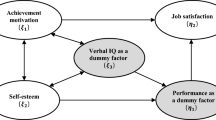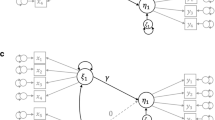Abstract
Moderated multiple regression (MMR) has been widely used to investigate the interaction or moderating effects of a categorical moderator across a variety of subdisciplines in the behavioral and social sciences. In view of the frequent violation of the homogeneity of error variance assumption in MMR applications, the weighted least squares (WLS) approach has been proposed as one of the alternatives to the ordinary least squares method for the detection of the interaction effect between a dichotomous moderator and a continuous predictor. Although the existing result is informative in assuring the statistical accuracy and computational ease of the WLS-based method, no explicit algebraic formulation and underlying distributional details are available. This article aims to delineate the fundamental properties of the WLS test in connection with the well-known Welch procedure for regression slope homogeneity under error variance heterogeneity. With elaborately systematic derivation and analytic assessment, it is shown that the notion of WLS is implicitly embedded in the Welch approach. More importantly, extensive simulation study is conducted to demonstrate the conditions in which the Welch test will substantially outperform the WLS method; they may yield different conclusions. Welch’s solution to the Behrens-Fisher problem is so entrenched that the use of its direct extension within the linear regression framework can arguably be recommended. In order to facilitate the application of Welch’s procedure, the SAS and R computing algorithms are presented. The study contributes to the understanding of methodological variants for detecting the effect of a dichotomous moderator in the context of moderated multiple regression. Supplemental materials for this article may be downloaded from brm.psychonomic-journals.org/content/supplemental.
Similar content being viewed by others
References
Aguinis, H. (2004). Regression analysis for categorical moderators. New York: Guilford.
Aguinis, H., Petersen, S. A., & Pierce, C. A. (1999). Appraisal of the homogeneity of error variance assumption and alternatives for multiple regression for estimating moderated effects of categorical variables. Organizational Research Methods, 2, 315–339.
Aguinis, H., & Pierce, C. A. (1998). Heterogeneity of error variance and the assessment of moderating effects of categorical variables: A conceptual review. Organizational Research Methods, 1, 296–314.
Aguinis, H., & Stone-Romero, E. F. (1997). Methodological artifacts in moderated multiple regression and their effects on statistical power. Journal of Applied Psychology, 82, 192–206.
Alexander, R. A., & DeShon, R. P. (1994). The effect of error variance heterogeneity on the power of tests for regression slope differences. Psychological Bulletin, 115, 308–314.
Alexander, R. A., & Govern, D. M. (1994). A new and simpler approximation for ANOVA under variance heterogeneity. Journal of Educational Statistics, 19, 91–101.
Berenson, M. L., Krehbiel, T. C., & Levine, D. M. (2006). Basic business statistics: Concepts and applications (10th ed.). Upper Saddle River, NJ: Pearson Education.
Best, D. J., & Rayner, J. C. W. (1987). Welch’s approximate solution for the Behrens-Fisher problem. Technometrics, 29, 205–210.
Davenport, J. M., & Webster, J. T. (1975). The Behrens-Fisher problem, an old solution revisited. Metrika, 22, 47–54.
DeShon, R. P., & Alexander, R. A. (1994). A generalization of James’s second-order approximation to the test for regression slope equality. Educational & Psychological Measurement, 54, 328–335.
DeShon, R. P., & Alexander, R. A. (1996). Alternative procedures for testing regression slope homogeneity when group error variances are unequal. Psychological Methods, 1, 261–277.
Dretzke, B. J., Levin, J. R., & Serlin, R. C. (1982). Testing for regression homogeneity under variance heterogeneity. Psychological Bulletin, 91, 376–383.
Fenstad, G. U. (1983). A comparison between the U and V tests in the Behrens-Fisher problem. Biometrika, 70, 300–302.
Ghosh, B. K. (1973). Some monotonicity theorems for χ2, F and t distributions with applications. Journal of the Royal Statistical Society B, 35, 480–492.
Howell, D. C. (2007). Statistical methods for psychology (6th ed.). Pacific Grove, CA: Duxbury.
James, G. S. (1951). The comparison of several groups of observations when the ratios of the population variances are unknown. Biometrika, 38, 324–329.
Nel, D. G., van der Merwe, C. A., & Moser, B. K. (1990). The exact distribution of the univariate and multivariate Behrens-Fisher statistics with a comparison of several solutions in the univariate case. Communications in Statistics: Theory & Methods, 19, 279–298.
Neter, J., Kutner, M. H., Nachtsheim, C. J., & Li, W. (2005). Applied linear statistical models (5th ed.). Chicago: McGraw-Hill/Irwin.
Overton, R. C. (2001). Moderated multiple regression for interactions involving categorical variables: A statistical control for heterogeneous variance across two groups. Psychological Methods, 6, 218–233.
Paul, S. R., Best, D. J., & Rayner, J. C. W. (1992). Comment on Best and Rayner (1987). Technometrics, 34, 249–250.
R Development Core Team (2008). R: A language and environment for statistical computing [Computer software and manual]. Retrieved from www.r-project.org.
Rencher, A. C. (2000). Linear models in statistics. New York: Wiley.
SAS Institute (2008). SAS/STAT 9.2 user’s guide. Cary, NC: SAS Institute Inc.
Scariano, S. M., & Davenport, J. M. (1986). A four-moment approach and other practical solutions to the Behrens-Fisher problem. Communications in Statistics: Theory & Methods, 15, 1467–1505.
Scheffé, H. (1970). Practical solutions of the Behrens-Fisher problem. Journal of the American Statistical Association, 65, 1501–1508.
Stone-Romero, E. F., Alliger, G. M., & Aguinis, H. (1994). Type II error problems in the use of moderated multiple regression for the detection of moderating effects of dichotomous variables. Journal of Management, 20, 167–178.
Welch, B. L. (1938). The significance of the difference between two means when the population variances are unequal. Biometrika, 29, 350–362.
Welch, B. L. (1951). On the comparison of several mean values: An alternative approach. Biometrika, 38, 330–336.
Author information
Authors and Affiliations
Corresponding author
Additional information
This research was partially supported by the National Science Council.
Electronic supplementary material
Rights and permissions
About this article
Cite this article
Shieh, G. Detection of interactions between a dichotomous moderator and a continuous predictor in moderated multiple regression with heterogeneous error variance. Behavior Research Methods 41, 61–74 (2009). https://doi.org/10.3758/BRM.41.1.61
Received:
Accepted:
Published:
Issue Date:
DOI: https://doi.org/10.3758/BRM.41.1.61




